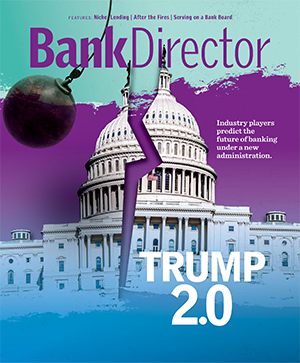
Using Embedded Finance to Grow Customers, Loans
Brought to you by Lendflow

Embedded finance is all around us, whether you know it or not.
Embedded finance is a type of transaction that a customer conducts without even realizing it – without any disruptions to their customer experience. Companies like Uber Technologies, Amazon.com, and Apple all leverage embedded finance in innovative ways to create impactful customer engagements. Today’s consumers are increasingly used to using embedded financial products to pay for a ride, buy large items and fill in cash-flow gaps.
But the explosion of embedded finance means that financial transactions that used to be the main focus of customer experiences are moving into the background in favor of more intuitive transactions. This is the whole point of embedded lending: creating a seamless customer experience centered around ease-of use, convenience and efficiency to enable other non-financial experiences.
Embedded lending extends embedded finance a step further. Embedded lending’s invisibility occurs through contextual placements within a product or platform that small to medium-sized businesses (SMBs) already use and trust. Because of embedded experiences, SMBs can get easier, faster access to capital.
All of this could put banks at a disadvantage when it comes to increasing their reach and identifying more and more qualified, high-intent SMBs seeking capital. But banks still have compelling options to capitalize on this innovative trend, such as:
- Joining embedded lending marketplaces. Banks can capitalize on embedded lending’s ability to open up new distribution channels across their product lines. Banks can not only protect their services but grow core products, like payments and loans, by finding distribution opportunities through embedded lending partners that match businesses looking for credit products and lenders on a marketplace.
Banks can take advantage of this strategy and generate sustained growth by using platforms, like Lendflow, that bring untapped distribution opportunities into the fold. This allows them to easily reach qualified, high-intent businesses seeking capital. Even better, their applications for credit occur at their point of need, which increases the likelihood they’ll qualify and accept the loan.
- Doubling down on traditional distribution channels. Another viable growth strategy for banks is to double down on providing better financial services and advice through traditional channels. Banks possess the inherent advantage of being in a position to not only supply products and services, but also provide ongoing advice as a trusted financial partner. Incorporating additional data points, such as payroll and cash flow data or social scoring, into their underwriting processes allows banks to leverage their unique position to develop more personalized products, improve customer experience and better support customers.
Embedded lending platforms can aggregate and normalize traditional and alternative data to help banks improve their credit decisioning workflows and innovate their underwriting processes.
- Reverse engineering on digital banking platforms. Banks can replicate this approach by embedding fintech products into their existing mobile app or digital banking platforms. Consider a bank that decides to provide shopping access through their online portals. In a case like this, a customer may apply for a car loan through the digital bank portal. The bank can then connect that customer to a local car dealership with whom they have a partnership – and potentially maintain revenue share arrangements with – to complete the transaction.
Lenders’ Crossroads Choice
Embedded finance’s effective invisibility of its services and products poses the biggest threat – or opportunity – to banks and traditional lenders. The convenience and ease of access of embedded financial products through platforms that customers already know and trust is an ongoing challenge traditional financial services providers. Yet embedded lending doesn’t have to be a threat for banks. Instead, banks should think of embedded lending as an opportunity to innovate their product lines and expand their reach to identify underserved small and medium-sized businesses in highly profitable industries.
Embedded lending opens a new world of underwriting possibilities because it relies on smarter data use. Platforms can pull data from multiple third-party sources, so lenders can efficiently determine whether or not a customer is qualified. With better data and smarter data use, fewer qualified customers get turned away, saving lenders time, cutting down underwriting costs and increasing conversion rates.


